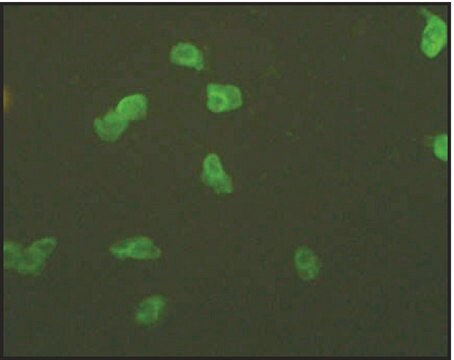추천 제품
생물학적 소스
mouse
Quality Level
결합
unconjugated
항체 형태
purified immunoglobulin
항체 생산 유형
primary antibodies
클론
BC-76, monoclonal
형태
buffered aqueous solution
종 반응성
human
기술
microarray: suitable
western blot: 5 μg/mL using total cell extracts of cultured HEK-293T cells treated with MG132
동형
IgM
UniProt 수납 번호
배송 상태
dry ice
저장 온도
−20°C
타겟 번역 후 변형
phosphorylation (pSer33)
유전자 정보
human ... CTNNB1(1499)
관련 카테고리
일반 설명
Cateninβ is a multifunctional protein, coded by CTNNB1 (cateninβ 1) gene. It is present in the intracellular side of the cytoplasmic membrane. It is located on human chromosome 3p22.1.
면역원
synthetic phosphopeptide corresponding to the region that contains serine 33 of human β-catenin.
애플리케이션
Monoclonal Anti-phospho-β-Catenin (pSer33) antibody produced in mouse is suitable for microarray and western blotting at a concentration of 5μg/mL using total cell extracts of cultured HEK-293T cells treated with MG132.
생화학적/생리학적 작용
Catenin (cadherin-associated protein), β 1 (88kDa) protein is encoded by CTNNB1 gene in humans. It is also called as β-catenin. It is a dual function protein that regulates the coordination of cell-cell adhesion and gene transcription. Human β-catenin is located at band p21 on chromosome 3.
Mutations in β-catenin results in retinal vascular condition FEVR (familial exudative vitreoretinopathy). It participates in stimulating disease progression, providing BCR–ABL (fusion gene) kinase-independent resistance and LSC (leukemic stem cell) self-renewal. CTNNB1 plays an important role in cell-to-cell adhesion and transcriptional modulation in the Wnt signalling pathway.
물리적 형태
Solution in 0.01 M phosphate buffered saline, pH 7.4, containing 1% bovine serum albumin and 15 mM sodium azide.
면책조항
Unless otherwise stated in our catalog or other company documentation accompanying the product(s), our products are intended for research use only and are not to be used for any other purpose, which includes but is not limited to, unauthorized commercial uses, in vitro diagnostic uses, ex vivo or in vivo therapeutic uses or any type of consumption or application to humans or animals.
적합한 제품을 찾을 수 없으신가요?
당사의 제품 선택기 도구.을(를) 시도해 보세요.
시험 성적서(COA)
제품의 로트/배치 번호를 입력하여 시험 성적서(COA)을 검색하십시오. 로트 및 배치 번호는 제품 라벨에 있는 ‘로트’ 또는 ‘배치’라는 용어 뒤에서 찾을 수 있습니다.
β-Catenin pathway activation in breast cancer is associated with triple-negative phenotype but not with CTNNB1 mutation.
Geyer FC, et al.
Modern Pathology, 24(2), 209?231-209?231 (2011)
Combined inhibition of β-catenin and Bcr?Abl synergistically targets tyrosine kinase inhibitor-resistant blast crisis chronic myeloid leukemia blasts and progenitors in vitro and in vivo.
Zhou H, et al.
Leukemia, 31(10), 2065?2074-2065?2074 (2017)
P D McCrea et al.
Science (New York, N.Y.), 254(5036), 1359-1361 (1991-11-29)
Three cytoplasmic proteins, called catenins, bind to the cytoplasmic tail of the epithelial cell-cell adhesion molecule E-cadherin. The complementary DNA sequence was determined for the 92-kilodalton beta catenin of Xenopus laevis. The sequence is homologous to mammalian plakoglobin, a protein
Defects in the Cell Signaling Mediator ?-Catenin Cause the Retinal Vascular Condition FEVR
Panagiotou ES, et al.
American Journal of Human Genetics, 100(6), 960-968 (2017)
C Kraus et al.
Genomics, 23(1), 272-274 (1994-09-01)
The human beta-catenin locus (CTNNB1) was mapped by in situ fluorescence analysis to band p21 on the short arm of chromosome 3, a region frequently affected by somatic alterations in a variety of tumors. PCR primers for the genomic amplification
자사의 과학자팀은 생명 과학, 재료 과학, 화학 합성, 크로마토그래피, 분석 및 기타 많은 영역을 포함한 모든 과학 분야에 경험이 있습니다..
고객지원팀으로 연락바랍니다.








